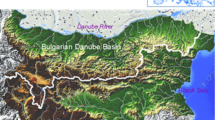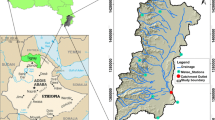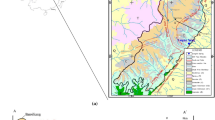Abstract
The objective of this work is the study of Opačac karst spring which geographically lies in Dalmatia (Croatia). Numerous studies have been carried out in karst aiming the investigation of groundwater regime. The karst spring hydrograph can reflect the groundwater regime and consequently the analysis is based on them. A simple conceptual rainfall–runoff model is used for the estimation of groundwater balance components including the influences of time-invariant catchment boundaries (Jukić and Denić-Jukić 2009). The proposed parameter estimation procedure merges the soil-moisture balance and the groundwater balance approaches to obtain the complete groundwater budget. The effective rainfall is calculated by using mathematical model based on soil-moisture balance equations, i.e. Palmer’s fluid mass balance method. The parameters of model of effective rainfall are determined by using simple conceptual rainfall–runoff model consisting of two linear reservoirs representing the fast and slow flow component of the recession. The weight coefficient between the fast and slow component is determined by using base flow index analysis of hydrograph. Recession coefficient of the slow flow component and the weight coefficient are determined from hydrograph analysis. Available data from nearby meteorological station includes daily average discharge, the amount of precipitation, the average temperature and the humidity from 1995 to 2010. The average catchment area is also estimated with the average yearly runoff deficit using Turc’s method and compared with the values obtained from the application of the rainfall–runoff model. Nash–Sutcliffe model efficiency, root mean square error and Pearson’s correlation coefficient for simulated hydrograph are applied to assess the predictive power of model. Calculated groundwater balance shows that the Opačac spring aquifer contains a significant storage capacity. The application of series of linear reservoirs is a classical and common technique, but the proposed simple approach enables the estimation of the components of groundwater balance in karst areas.









Similar content being viewed by others
References
Bakalowicz M (2005) Karst groundwater: a challenge for new resources. Hydrogeol J 13(1):148–160
Bojanić L, Ivičić D, Batić V (1981) Hidrogeologija Imotskog polja s osvrtom na značaj u regionalnom smislu [Hydrogeology of Imotski Polje with review on regional significance]. Geološki Vjesnik 34:127–135
Bonacci O, Roje-Bonacci T (2008) Water losses from the Ričice reservoir built in the Dinaric karst. Eng Geol 99(3–4):121–127. doi:10.1016/j.enggeo.2007.11.014
Bonacci O, Željković I, Galić A (2013) Karst rivers’ particularity: an example from Dinaric karst (Croatia/Bosnia and Herzegovina). Environ Earth Sci 70:963–974
Boussinesq J (1904) Recherches theoretique sur l’ecoulement des nappes d’eau infiltrees dans le sol et sur le debit des sources. J Math Pure Appl 10(5th Series):5–78
Brodie RS, Hostetler S (2005) A review of techniques for analysing base flow from stream hydrographs. In: Proceedings of the NZHS-IAH-NZSSS 2005 conference, 28 November–2 December, Auckland
Brušková V (2008) Assessment of the base flow in the upper part of Torysa river catchment. Slovak J Civ Eng 2008(2):8–14
Butscher C, Huggenberger P (2008) Intrinsic vulnerability assessment in karst areas: a numerical modeling approach. Water Resour Res 44:W03408. doi:10.1029/2007WR006277
Charlier JB, Bertrand C, Mudry J (2012) Conceptual hydrogeological model of flow and transport of dissolved organic carbon in a small Jura karst system. J Hydrol 460–461:52–64
Denić-Jukić V, Jukić D (2003) Composite transfer functions for karst aquifers. J Hydrol 274:80–94
Eagleman JR (1967) Pan evaporation, potential and actual evapotranspiration. J Appl Meteorol 6:482–488
Eckhardt K (2005) How to construct recursive digital filters for base flow separation. Hydrol Process 19:507–515
Eisenlohr L, Kiraly L, Bouzelboudjen M, Rossier Y (1997a) A numerical simulation as a tool for checking the interpretation of karst springs hydrographs. J Hydrol 193:306–315
Eisenlohr L, Bouzelboudjen M, Kiraly L, Rossier Y (1997b) Numerical versus statistical modelling of natural response of a karst hydrogeological system. J Hydrol 202:244–262
Fleury P, Plagnes V, Bakalowicz M (2007) Modelling of the functioning of karst aquifers with a reservoir model: application to Fontaine de Vaucluse (South of France). J Hydrol 345:38–49
Goldscheider N, Drew D, Worthington S (2007). Introduction. In: Goldscheider N, Drew D (eds), Methods in karst hydrogeology. Taylor & Francis, London. Int Contrib Hydrogeol 26: 1–8
Halihan T, Wicks CM (1998) Modeling of storm responses in conduit flow aquifers with reservoirs. J Hydrol 208:82–91
Hartmann A, Kralik M, Humer F, Lange J, Weiler M (2012) Identification of a karst system’s intrinsic hydrodynamic parameters: upscaling from single springs to the whole aquifer. Environ Earth Sci 65:2377–2389
Hartmann A, Barberá JA, Lange J, Andreo B, Weiler M (2013) Progress in the hydrologic simulation of time variant recharge areas of karst systems—exemplified at a karst spring in Southern Spain. Adv Water Resour 54:149–160. doi:10.1016/j.advwatres.2013.01.010
Hartmann A, Goldscheider N, Wagener T, Lange J, Weiler M (2014) Karst water resources in a changing world: review of hydrological modeling approaches. Rev Geophys. doi:10.1002/2013RG000443
Herak M (1986) A new concept of geotectonics of the Dinarides. Acta Geol 16:1–42
Hisdal H, Tallaksen LM, Clausen B, Peters E, Gustard A (2004) Hydrological drought characteristics. In: Tallaksen LM, van Lanen HAJ (eds) Hydrological drought—processes and estimation methods for stream flow and groundwater, vol 48., Developments in water sciencesElsevier, Amsterdam, pp 139–198
Horton RE (1933) The role of infiltration in the hydrological cycle. Trans Am Geophys Union 14:446–460
Johannet A, Mangin A, D’Hulst D (1994) Subterranean water infiltration modelling by neural networks: use of water source flow. ICANN ‘94—proceedings of the international conference on artificial neural networks, Sorrento, Italy, 26–29 May 1994. Spring, London, pp 1033–1036
Jukić D, Denić-Jukić V (2004) A frequency domain approach to groundwater recharge estimation in karst. J Hydrol 289(1–4):95–110. doi:10.1016/j.jhydrol.2003.11.005
Jukić D, Denić-Jukić V (2006) Nonlinear kernel functions for karst aquifers. J Hydrol 328:360–374
Jukić D, Denić-Jukić V (2009) Groundwater balance estimation in karst by using a conceptual rainfall–runoff model. J Hydrol 373(2009):302–315
Kiraly L, Perrochet P, Rossier Y (1995) Effect of the epikarst on hydrograph of karst springs: a numerical approach. Bull Cent Hydrogeol Neuchatel 14:199–220
Klemeš V (1986) Operational testing of hydrological simulation models. Hydrol Sci J 31(1):13–24
Kresic N, Stevanovic Z (2010) Groundwater hydrology of springs: engineering, theory, management, and sustainability. Butterworth-Heinemann, Elsevier, Jordan Hill, Oxford, pp 312–316
Kuhta M, Brkić Ž, Stroj A (2012) Hydrodynamic characteristics of Mt. Biokovo foothill springs in Croatia. Geol Croat 65(1):41–51. doi:10.4154/gc.2012.03
Kurtulus B, Razack M (2006) Evaluation of the ability of an artificial neural network model to simulate the input–output responses of a large karstic aquifer: the La Rochefoucauld aquifer (Charente, France). Hydrogeol J 15:241–254
Le Moine N, Andréassian V, Perrin C, Michel C (2007) How can rainfall-runoff models handle intercatchment groundwater flows? Theoretical study based on 1040 French catchments. Water Resour Res 43:1–11. doi:10.1029/2006WR005608
Le Moine N, Andreassen V, Mathevet T (2008) Confronting surface- and groundwater balances on the La Rochefoucauld-Touvre karstic system (Charente, France). Water Resour Res 44:W03403. doi:10.1029/2007WR005984
Maillet E (1905) Essais d’Hydraulique Souterraine et Fluviale. Hermann, Paris
Mangin A (1984) Pour une meilleure connaissance des systemes hydrologiques a partir des analyses correlatoire et spectrale. J Hydrol 67:25–43
Nash JE, Sutcliffe JV (1970) River flow forecasting through conceptual models. Part I—a discussion of principles. J Hydrol 10(3):282–290
Nathan RJ, McMahon TA (1990) Evaluation of automated techniques for baseflow and recession analysis. Water Resour Res 26:1465–1473
Padilla A, Pulido-Bosch A (1995) Study of hydrographs of karstic aquifers by means of correlation and cross-spectral analysis. J Hydrol 168(1–4):73–89
Padilla A, Pulido-Bosch A (2008) Simple procedure to simulate karstic aquifers. Hydrol Process 22(12):1876–1884
Palmer WC (1965) Meteorological drought, US Department of Commerce, Research Paper No. 45, Washington DC, 58 p
Pandžić K (1985) Bilanca vode na istočnom primorju Jadrana (Water balance on the eastern Adriatic coastal region). Hrvatski meteorološki časopis, vol.20 No.20 Prosinac 1985
Pandžić K, Šimunić I, Tomić F, Husnjak S, Likso T, Petošić D (2006) Comparison of three mathematical models for the estimation of 10-day drain discharge. Theor Appl Climatol 85:107–115. doi:10.1007/s00704-005-0165-9
Pedersen JT, Peters JC, Helweg OJ (1980) Hydrographs by single linear reservoir model. USACF. TP-74
Penzar B (1976) Indeksi suhoće za Zagreb i njihova statistička prognoza (Drought severity index for Zagreb and its statistical forecast). Hrvatski meteorološki časopis 13(13):58
Petras I (1986) An approach to the mathematical expression of recession curves. Water SA 12(3):145–150
Pinault JL, Plagnes V, Aquilina L, Bakalowicz M (2001) Inverse modelling of the hydrological and the hydrochemical behaviour of hydrosystems: characterization of karst system functioning. Water Resour Res 37(8):2191–2204
Schumann AH (1993) Development of conceptual semi-distributed hydrological models and estimation of their parameters with the aid of GIS. Hydrol Sci 38(6):519–528
Singh VP (1988) Rainfall–runoff modelling, hydrologic systems, vol 1 and 2. Prentice-Hall, Englewood Cliffs
Turc L (1954) Le bilan d'eau des sols: relation entre les précipitations, l'évaporation et l'écoulement. Troisièmes journées de l'Hydraulique, Alger 12-14 avril 1954, pp 36-43. (Résumé de la thèse de l'auteur, Paris, 1953, parue ds Ann. Agron. 1954 et Sols Africains, vol. 111, 1954)
Author information
Authors and Affiliations
Corresponding author
Rights and permissions
About this article
Cite this article
Željković, I., Kadić, A. Groundwater balance estimation in karst by using simple conceptual rainfall–runoff model. Environ Earth Sci 74, 6001–6015 (2015). https://doi.org/10.1007/s12665-015-4624-z
Received:
Accepted:
Published:
Issue Date:
DOI: https://doi.org/10.1007/s12665-015-4624-z




